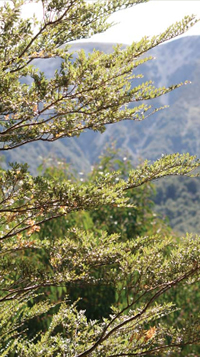Sustainable Industry
Outcome: New Zealand industries and organisations have increased ability to develop within environmental limits and meet market and community requirements
 Beech timber production systems
Beech timber production systems
Almost 20 years on from legislative changes to the way indigenous beech forests are harvested, a Landcare Research review has found that, with appropriate management systems, harvesting can take place without affecting the health of remaining trees.
The review shows New Zealand has a wealth-creation opportunity through building an industry based upon the sustainable management of a portion of our 1.5 million hectares of privately owned indigenous forests, including 300,000 ha owned by Māori. However, perceived difficulties around stand stability and regeneration following harvesting have long limited the development of a beech timber industry, says Ecosystem Processes Science Team Leader, Rob Allen.
‘Indigenous forestry has long been a controversial issue. A key issue is whether timber can be extracted while maintaining or even enhancing the non-extractive benefits of these forests, such as biodiversity, water quality, carbon and cultural identity,’ he says.
Dr Allen assessed and summarised studies of seven trials where beech species have been harvested in accordance with 1993 legislation.
‘We studied what was known about the direct influences of harvesting on tree recruitment, growth and mortality, and, where studied, on other natural values. Some general conclusions can be made about the management systems used,’ Dr Allen says.
The research found that in most places beech regenerates following harvest and that residual beech stands are usually stable.
Beech trees grow slowly, and stands regenerating from past felling develop into dense even-aged thickets of saplings and pole-sized trees where individual stem diameter growth rates are in the order of 2 mm per year, with expected rotations of more than 120 years. However, beech saplings respond well when freed from neighbouring competition.
‘Quantitative assessments show that, with the exception of coupes harvested in black beech, the systems have not so far dramatically impacted on residual tree mortality.’
The assessment contrasted with reviews of beech harvesting prior to 1993, where extraction intended to be low-impact caused limited regeneration and significantly elevated tree mortality.
Dr Allen says harvesting since 1993 has typically led to prolific forest regeneration at a range of locations, especially following group or coupe harvesting. The > 4 m height requirement for adjacent harvesting has often been achieved in about 10 years.
‘Prolific regeneration in homogeneous patches favours the development of long clean straight trunks by natural competition but, eventually, it can lead to stagnant growth of individual trees and compromise stand stability. Thus there is currently some interest in improving tree growth and product quality through thinning and pruning the dense regenerating stands.
‘So far these management systems outlined have only been assessed over a small part of the beech management cycle, and further issues will be resolved through time. For example, whether the group-selection system in red–silver beech forest, or the selection harvest in silver beech forest, will provide adequate canopy openings for a regenerative response to reach the canopy, in the face of lateral expansion of the residual tree crowns, remains unresolved.
‘This could have important consequences for coexistence of canopy tree species in red–silver beech forests. Superimposing small-coupe and group management systems on relatively even-aged second-growth beech forest may well lead to some attributes of old-growth forest such as structural complexity, presence of several cohorts of trees, and variation in tree size. However, there is also some evidence that these systems create opportunities for short-lived early successional species (e.g. tree fuchsia and wineberry) rather than the late successional, shade-tolerant species often associated with old-growth forest.’
Dr Allen says that, to some degree, the varying responses to different types of management reflect the context within which the management was applied, rather than the management itself.
‘For example, trees found on fertile soils, where canopies intercept much of the light, exhibit strong competition with neighbouring trees when compared with trees found on infertile soils.
